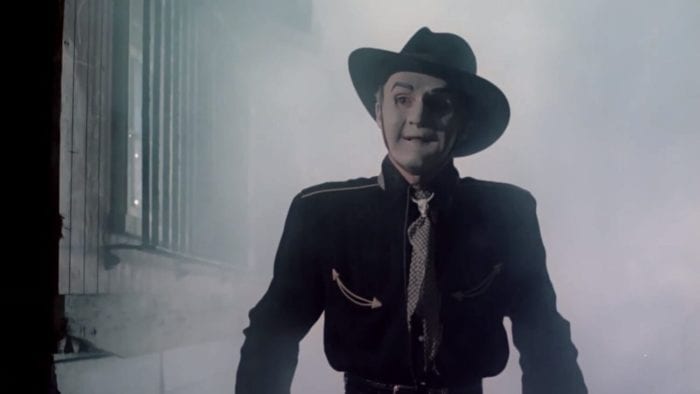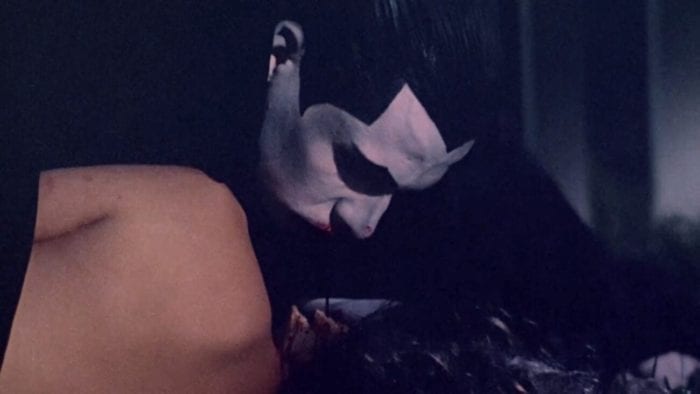Near the end of Scream, Billy Loomis (Skeet Ulrich) declares, “Movies don’t create psychos. Movies make psychos more creative.” This remark was meant in defense of horror films from the political scapegoating and finger pointing in society. Many suggesting that violent images seen in movies and television influence the mind. And while I wouldn’t argue that imagery does have some effect on the mind it does not turn us all into vicious psycho killers.
In 1980, writer/director Vernon Zimmerman had a similar theory. Fade to Black bases itself off James Thurber’s The Secret Life of Walter Mitty and Keith Waterhouse’s Billy Liar, both involving individuals that detach from society to live in a fantasy world. Where those stories stay playful, Fade to Black becomes increasingly dark as Eric (Dennis Christopher) allows a lifetime of psychological frustration to split off into his favorite movie characters.
Fade to Black is about an awkward twenty-something with a passionate affection for film living at home with his embittered Aunt Stella (Eve Brent). Aunt Stella is bound to a wheelchair, quite like Joan Crawford in What Ever Happened to Baby Jane? all the while looking similarly to Bette Davis in the that film. Eric and Stella have a mutually abusive relationship not unlike the characters of Baby Jane as well. While Stella still maintains an affinity for Eric, she maintains her resentment of him. Telling him that he’s the reason she lost her legs after leaving a party one night to take care of him.

Eric works all day at a film storage facility where he’s bullied by his co-worker Richie (an almost unrecognizably young Mickey Rourke). Eric meets Marilyn (Linda Kerridge), a girl who bears striking resemblance to Marilyn Monroe. When she stands him up outside a movie theater, Eric seeks solace in the warm light of a celluloid film print of White Heat. When Stella attacks the movie it’s curtains for her.
This might be the last straw for Eric’s sanity when Stella breaks his film reel, but his break isn’t really sudden. From what the film shows us early on, he reenacts pieces of films to the ire of Stella. Years of social awkwardness and introversion only promote an idea that films are his only friend. The idea that “the movie made him do it” isn’t the case, and, in the words of Billy Loomis, it only makes Eric “more creative”.
Mimicking a scene from Kiss of Death, Eric pushes his crippled aunt down a flight of stairs snickering like Richard Widmark in the film. This begins his melding of reality and fantasy as he becomes more peculiar in the coming days. Eric changes the mailbox and street sign to reflect the name and address of Cagney’s White Heat character, Cody Jarrett. Embodying Cody, Eric begins to pursue any person who has ever wronged him in spectacular fashion by emulating his favorite films.

His breaking point is a delayed reaction to being stood up and not being allowed to cope the only way he knows how. Eric’s mental stability isn’t okay from the beginning of the film, but it doesn’t help him any that people are calling the only thing he’s good at, movie trivia, useless. And I’m not just saying that as a film reviewer. As Eric continues his movie-themed rampage it becomes clearer to the viewer that Eric doesn’t understand social norms, pulling a Psycho on Marilyn in her shower.
Embarrassed, Eric takes his rage out on a sex worker who insulted him while he was being stood-up by Marilyn. Stalking her in his Dracula costume before she trips and impales herself on a fence. This death is so implicitly clever in the film. It draws on impressions from Dracula with Eric seeing a wooden steak plunged through the girl’s neck. This creates the impression in Eric’s mind he is living out the movie, drinking the girl’s blood from her wound. It’s also indicative of Eric’s perversion to murder, seeing Marilyn naked in the shower then immediately slaying, not just any sex worker, but the one that embarrassed him during an extremely vulnerable moment.
Eric seems to maintain himself until he’s pushed into aggravation once again by Richie. Richie, being the jock type, needs to be met with an equally formidable type. Eric shows up at the pier dressed as William Boyd’s noble gunslinger, Hopalong Cassidy, challenging Richie to a duel. Before killing Richie, Eric reveals himself taking pride in the man he’s becoming. It’s important to note here that Eric is literally becoming someone else from the kid we first see on screen. He’s becoming Cody Jarrett.

We witness more of this transformation throughout the next few scenes. Eric is brought in for questioning with Bart (Hennen Chambers), Richie’s best friend. While exiting we see Eric’s rise in confidence as he confidently threatens Bart. We see it again when Eric talks to his boss about getting his posters back after being fired. Getting his revenge, he scares his boss to death by chasing him through the warehouse as The Mummy. Whenever Eric lives out a movie, he believes it gives him more power which enhances his self-confidence.
As Zimmerman begins Fade to Black‘s final act, Eric meets Marty Berger (Norman Burton) while hitchhiking. Marty is driving a beautiful 1934 Auburn Speedster and the front seat contains a handful of movie scripts. Excited to meet a movie producer, Eric tells Marty his blockbuster movie idea. Marty loves it and tells Eric to call him at the studio.
Eric is beaming from the ride with Marty so much that he begins to tell his Aunt Stella all about it. As Eric realizes that she’s no longer there, he becomes repentant. Eric calls Stella his mom. This isn’t the first time. This time, however, the viewer gets the impression that Stella was his mother. Deciphering that she never wanted him in the first place, afraid that having a child would cost her opportunities in her dance career. Eric’s bereavement and guilt about what he’s done breathes a revelation into Stella’s own unsettled psychological issues—delusions of grandeur she piled on Eric. A sentiment Dr. Moriarty (Tim Thomerson), the local police department’s new psychologist, believes as well.

Believing everything is going his way, Eric heads to a department store for a new color TV. Here he sees Marty all over the screens promoting his ideas on a talk show and gets incredibly excited. Eric calls Marty who immediately laughs him off. It’s a great concept. The movies are Eric’s friends, but here the movie industry turns against him. The fun part in all of this being producers are not movies. Ideas cannot be stopped, especially in the mind of fanatics.
Marty meets his end by way of Cody Jarrett’s Tommy gun in true gangster fashion. Eric begins his grand gesture to Marilyn by luring her to a photo shoot at Blow-Up photo studio, a reference to Michelangelo Antonioni’s 1966 film about a photographer who captures a murder on film. Inside the studio, Eric adorns a costume of a foreign prince and invites Marilyn to join him in a scenery replica of the Marilyn Monroe picture, The Prince and the Showgirl.
Moriarty and his partner finally catch up to Eric. Eric gives Marilyn a pill and takes one himself before shooting Moriarty in the leg. I think the idea of Dr. Moriarty’s approach in bringing a psychological evaluation helps deviate this movie from many B-movies of the time. His initial ideas and introspection serve as a progressive take in a time that considered forensic psychology to be mumbo jumbo.

Unfortunately for all his setup, Moriarty assists in finding Eric but never gets to help him. I guess in this way, the movie uses him like Halloween uses Michael Myers doctor, Dr. Loomis (Donald Pleasance). Eric is watching Halloween in his room at one point, but the viewer only hears Loomis speak on a payphone. Dr. Loomis also being referenced as Billy’s last name in Scream.
The final scenes of Fade to Black take place atop the world-famous Grauman’s Chinese theater. A perfect place for a movie about movies to end when you think about it. Eric gives Marilyn the rest of the pills and tells her to take them so the two can be together, then pushes her back inside the rooftop entrance. Coming nearer to the edge, Eric’s mind connects the scene. It’s Cody Jarrett’s last hurrah. Eric takes his final bow and attempts to recite the final lines of White Heat, “Made it Ma! Top of the world!” Unfortunately, Eric’s remake isn’t as strong as he is shot multiple times swan diving onto the pavement.
You have to give a lot of credit to Zimmerman here for crafting a script like this so far ahead of its time. Not only is Eric’s transformation into Cody a hell of a journey, he treats him with such care knowing that underneath he’s just a messed-up kid. Zimmerman loves using the power of other film’s narratives to enhance Eric’s story and make it work on a psychological level. In doing this, he also guides the audience through the parallels to movies Eric sees in his daily life before taking it further and creating his own semblances.

Fade to Black is also a clear inspiration for 2019’s Joker. The similarities in the films’ take on psychosis, mothers, lust, and celebrity are just far too obvious to ignore. Eric’s indifference to the chaos he’s causing is what makes the movie a perfect template for a film like Joker.
Cody Jarrett in White Heat, for instance, is a character fixated on his mother and plagued by migraines. Many ’30s and ’40s films used issues like headaches as plot devices to simplify criminal psychological issues. One such example, Blind Alley, uses a single hypno-therapy session to thwart a crime boss with a psychosomatic hand problem.
I do feel a little slighted by not knowing the fate of Marilyn at the end. Did she take the rest of the pills and suffer Monroe’s fate? We know she took the one pill in the photo studio, but could she have survived? Had she realized Eric had gone mad? Did she really never put together that Eric was the Dracula that caused her Psycho shower scene?
Regardless, Fade to Black was a surprising ride I was not expecting to take. This movie genuinely surprised me. I loved all the Easter eggs and cap tips to films and I’m certain I didn’t even catch them all. Zimmerman set up a Where’s Waldo in film form and it was quite entertaining to play.
Fade to Black is now streaming on Shudder.



